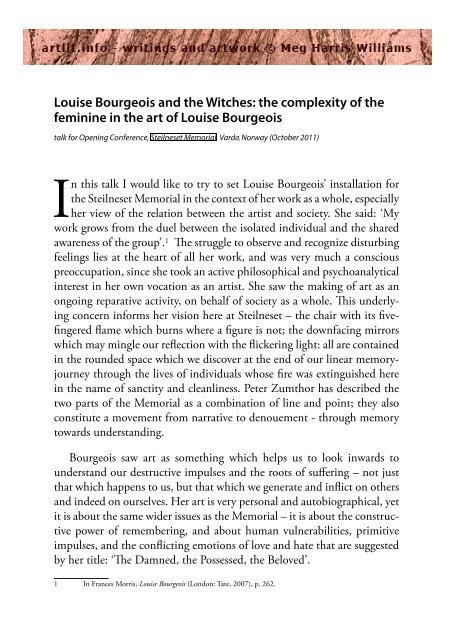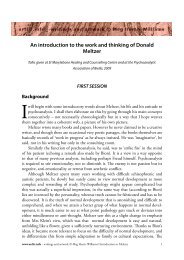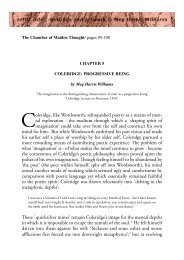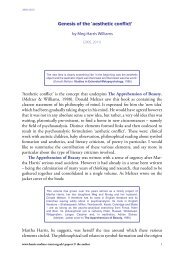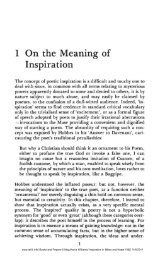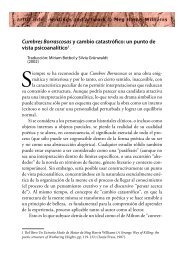Louise Bourgeois and the Witches: the complexity of the ... - Artlit
Louise Bourgeois and the Witches: the complexity of the ... - Artlit
Louise Bourgeois and the Witches: the complexity of the ... - Artlit
Create successful ePaper yourself
Turn your PDF publications into a flip-book with our unique Google optimized e-Paper software.
<strong>Louise</strong> <strong>Bourgeois</strong> <strong>and</strong> <strong>the</strong> <strong>Witches</strong>: <strong>the</strong> <strong>complexity</strong> <strong>of</strong> <strong>the</strong><br />
feminine in <strong>the</strong> art <strong>of</strong> <strong>Louise</strong> <strong>Bourgeois</strong><br />
talk for Opening Conference, Steilneset Memorial, VardØ, Norway (October 2011)<br />
In this talk I would like to try to set <strong>Louise</strong> <strong>Bourgeois</strong>’ installation for<br />
<strong>the</strong> Steilneset Memorial in <strong>the</strong> context <strong>of</strong> her work as a whole, especially<br />
her view <strong>of</strong> <strong>the</strong> relation between <strong>the</strong> artist <strong>and</strong> society. She said: ‘My<br />
work grows from <strong>the</strong> duel between <strong>the</strong> isolated individual <strong>and</strong> <strong>the</strong> shared<br />
awareness <strong>of</strong> <strong>the</strong> group’. 1 The struggle to observe <strong>and</strong> recognize disturbing<br />
feelings lies at <strong>the</strong> heart <strong>of</strong> all her work, <strong>and</strong> was very much a conscious<br />
preoccupation, since she took an active philosophical <strong>and</strong> psychoanalytical<br />
interest in her own vocation as an artist. She saw <strong>the</strong> making <strong>of</strong> art as an<br />
ongoing reparative activity, on behalf <strong>of</strong> society as a whole. This underlying<br />
concern informs her vision here at Steilneset – <strong>the</strong> chair with its fivefingered<br />
flame which burns where a figure is not; <strong>the</strong> downfacing mirrors<br />
which may mingle our reflection with <strong>the</strong> flickering light: all are contained<br />
in <strong>the</strong> rounded space which we discover at <strong>the</strong> end <strong>of</strong> our linear memoryjourney<br />
through <strong>the</strong> lives <strong>of</strong> individuals whose fire was extinguished here<br />
in <strong>the</strong> name <strong>of</strong> sanctity <strong>and</strong> cleanliness. Peter Zumthor has described <strong>the</strong><br />
two parts <strong>of</strong> <strong>the</strong> Memorial as a combination <strong>of</strong> line <strong>and</strong> point; <strong>the</strong>y also<br />
constitute a movement from narrative to denouement - through memory<br />
towards underst<strong>and</strong>ing.<br />
<strong>Bourgeois</strong> saw art as something which helps us to look inwards to<br />
underst<strong>and</strong> our destructive impulses <strong>and</strong> <strong>the</strong> roots <strong>of</strong> suffering – not just<br />
that which happens to us, but that which we generate <strong>and</strong> inflict on o<strong>the</strong>rs<br />
<strong>and</strong> indeed on ourselves. Her art is very personal <strong>and</strong> autobiographical, yet<br />
it is about <strong>the</strong> same wider issues as <strong>the</strong> Memorial – it is about <strong>the</strong> constructive<br />
power <strong>of</strong> remembering, <strong>and</strong> about human vulnerabilities, primitive<br />
impulses, <strong>and</strong> <strong>the</strong> conflicting emotions <strong>of</strong> love <strong>and</strong> hate that are suggested<br />
by her title: ‘The Damned, <strong>the</strong> Possessed, <strong>the</strong> Beloved’.<br />
1 In Frances Morris, <strong>Louise</strong> <strong>Bourgeois</strong> (London: Tate, 2007), p. 262.
The Memorial, I believe, is not only about remembering but also about<br />
reparation for past crimes, <strong>and</strong> about reflecting in what sense it is indeed<br />
possible to reverse or modify <strong>the</strong> injury dealt to those who were murdered<br />
not by crazy individuals but by respectable society hundreds <strong>of</strong><br />
years ago. The Memorial brings to present-day attention something which<br />
might have been buried: <strong>the</strong> persecution <strong>of</strong> those who became scapegoats<br />
owing to society’s suspicion that <strong>the</strong>y had gained satanic powers or hidden<br />
occult knowledge that was liable to destroy some part <strong>of</strong> <strong>the</strong> social fabric<br />
– some religious, racial, or economic imbalance, or subversion in <strong>the</strong> relations<br />
between <strong>the</strong> sexes (since witches were mainly women). The dominant<br />
social group, driven by fear <strong>and</strong> intolerance, selected individuals who<br />
manifest some kind <strong>of</strong> weakness, oddness, inferiority, or even talent, <strong>and</strong><br />
used <strong>the</strong>m to exorcise unwanted feelings. As is well known psychologically,<br />
<strong>the</strong> guilt <strong>of</strong> <strong>the</strong> persecutor (if unfelt <strong>and</strong> unacknowledged) is projected<br />
onto <strong>the</strong> victim, who <strong>the</strong>n becomes an object full <strong>of</strong> bad or dangerous<br />
qualities. The illusion is <strong>the</strong>n that <strong>the</strong> feelings can be destroyed along with<br />
<strong>the</strong>ir container. Freud (as <strong>Bourgeois</strong> will have known) was interested in <strong>the</strong><br />
phenomenon <strong>of</strong> witches <strong>and</strong> in <strong>the</strong> similarity between confessions made<br />
under torture, <strong>and</strong> <strong>the</strong> phantasies <strong>of</strong> some <strong>of</strong> his ‘hysterical’ patients: <strong>and</strong><br />
<strong>the</strong> similarity between <strong>the</strong> medieval <strong>the</strong>ory <strong>of</strong> possession <strong>and</strong> <strong>the</strong> psychoanalytic<br />
<strong>the</strong>ory <strong>of</strong> ‘a foreign body <strong>and</strong> a splitting <strong>of</strong> consciousness’. 2 The<br />
social disease which creates witches is analogous to <strong>the</strong> psychological one<br />
induced by hysteria <strong>and</strong> is to do with <strong>the</strong> human failure to take responsibility<br />
for threatening or frightening feelings.<br />
<strong>Bourgeois</strong> emphasized that <strong>the</strong> emotions she was dealing with were<br />
‘universal’ ones. Instead <strong>of</strong> ‘conversation pieces’, she said, her sculptures<br />
were ‘confrontation pieces’. 3 They aim to engage <strong>the</strong> viewer emotionally.<br />
Sometimes, especially when <strong>the</strong>y involve <strong>the</strong> portrayal <strong>of</strong> dismembered<br />
body parts, <strong>the</strong>y have been found disturbing; but she said her intention<br />
was to be ‘accurate not shocking’. 4 In her art she tries to see ‘what is, not<br />
what I would like’. 5 The subject may be violent or ugly but <strong>the</strong> art created<br />
may still be beautiful; this is not to glamourise <strong>the</strong> subject, but to endow<br />
2 Freud, S., letter 56 from extract from <strong>the</strong> Fliess Papers (1897), St<strong>and</strong>ard Edition I: 242.<br />
3 In Destruction <strong>of</strong> <strong>the</strong> Fa<strong>the</strong>r/Reconstruction <strong>of</strong> <strong>the</strong> Fa<strong>the</strong>r: Writings <strong>and</strong> Interviews, ed. Marie-Laure Bernadac<br />
<strong>and</strong> Hans-Ulrich Obrist (Cambridge, Mass: The MIT Press, 1998), p. 66.<br />
4 Christianne Meyer-Thoss in conversation (Zurich: Ammann Verlag 1992), p. 119.<br />
5 <strong>Louise</strong> <strong>Bourgeois</strong>, dir. by Nigel Finch (London: Arena Films, 1993). Edited transcript in Bernadac & Obrist,<br />
p. 261.<br />
www.artlit.info - writings <strong>and</strong> artwork © Meg Harris Williams/ <strong>Bourgeois</strong> <strong>and</strong> <strong>the</strong> witches 2
it with <strong>the</strong> kind <strong>of</strong> underst<strong>and</strong>ing that is beautiful in itself, founded as it is<br />
on not hiding or denying those primitive aspects <strong>of</strong> ourselves that it is better<br />
to acknowledge. She was interested, she said, in <strong>the</strong> irrational roots <strong>of</strong><br />
aggression <strong>and</strong> how ‘we destroy <strong>the</strong> very thing we most desire’. 6 She speaks<br />
<strong>of</strong> <strong>the</strong> ‘monster’ within or <strong>the</strong> ‘deadly beast that inhabits me’, 7 <strong>of</strong> being in<br />
a ‘creativity rage’ <strong>and</strong> transferring feelings she experienced 40 years ago. 8<br />
Looking in <strong>the</strong> mirror she sees a ‘Medusa’, 9 <strong>the</strong> ugliness <strong>of</strong> a non-idealized<br />
reflection. Contradicting Sartre - <strong>and</strong> certainly contradicting <strong>the</strong> ecclesiastical<br />
judges who condemned <strong>the</strong> witches - she insisted that hell is not in<br />
o<strong>the</strong>r people: ‘hell is inside you’. 10<br />
The point <strong>of</strong> unearthing buried feelings however is not to repeat but<br />
to revise. Unpleasant feelings are not to be remembered passively or with<br />
self-pity, but ra<strong>the</strong>r should be used as fuel to ‘burn through’ a new work<br />
(to borrow a phrase <strong>of</strong> Keats – who wrote ‘<strong>the</strong> fierce dispute/ Betwixt damnation<br />
<strong>and</strong> impassion’d clay/ Must I burn through’). 11 This is <strong>the</strong> healing<br />
function <strong>of</strong> art. Aggression in her view was connected with fear – <strong>of</strong> <strong>the</strong><br />
unknown or <strong>the</strong> alien – such as we find in society’s view <strong>of</strong> witches. ‘In real<br />
life ‘, she said, ‘I identify with <strong>the</strong> victim; in my art I am <strong>the</strong> murderer.’ 12 In<br />
this she was referring to <strong>the</strong> rhythm <strong>of</strong> destroying-to-recreate that underlies<br />
<strong>the</strong> artist’s use <strong>of</strong> materials. The very making <strong>of</strong> art, especially sculpture,<br />
involves a rhythm <strong>of</strong> attack <strong>and</strong> reparation. It echoes <strong>the</strong> psychological<br />
process <strong>of</strong> investigating <strong>the</strong> destructive impulses within oneself, but with a<br />
creative purpose.<br />
For to represent murder in art, or to attack a piece <strong>of</strong> stone with an artistic<br />
purpose, is <strong>the</strong> precise opposite <strong>of</strong> acting murderously in life: ‘I am free<br />
because I use <strong>the</strong> aggression I am suffering from against <strong>the</strong> sculpture’. 13<br />
The exposure is a kind <strong>of</strong> catharsis or exorcism (both words she uses) that<br />
checks violent action <strong>and</strong> converts its energies into beauty <strong>and</strong> harmony.<br />
‘To be an artist is to guarantee to your fellow human that <strong>the</strong> wear <strong>and</strong> tear<br />
<strong>of</strong> living will not let you become a murderer’. 14 Artists – as people - don’t<br />
6 In <strong>Louise</strong> <strong>Bourgeois</strong> ed Robert Storr, Paulo Herkenh<strong>of</strong>f, Allan Schwartzman. Phaidon (2003), p. 117.<br />
7 <strong>Louise</strong> <strong>Bourgeois</strong> unpublished notes held at <strong>the</strong> <strong>Louise</strong> <strong>Bourgeois</strong> Studio (LB-0356).<br />
8 <strong>Louise</strong> <strong>Bourgeois</strong> unpublished notes LB-0566.<br />
9 <strong>Louise</strong> <strong>Bourgeois</strong> Diary held at <strong>the</strong> <strong>Louise</strong> <strong>Bourgeois</strong> Studio, November 13, 1992.<br />
10 In Bernadac & Obrist, p. 269.<br />
11 John Keats, ‘On sitting down to read King Lear once again’.<br />
12 <strong>Louise</strong> <strong>Bourgeois</strong> Diary April 30, 1992<br />
13 In Frances Morris, <strong>Louise</strong> <strong>Bourgeois</strong>, p. 36<br />
14 <strong>Louise</strong> <strong>Bourgeois</strong> Diary August 27, 1984<br />
www.artlit.info - writings <strong>and</strong> artwork © Meg Harris Williams/ <strong>Bourgeois</strong> <strong>and</strong> <strong>the</strong> witches 3
get better <strong>and</strong> better, she said, but <strong>the</strong>y become ‘able to st<strong>and</strong> more’. 15<br />
Owing to a privileged access to <strong>the</strong> unconscious, <strong>the</strong>y become ‘aware <strong>of</strong><br />
an anxiety crisis’ that is <strong>the</strong>n solved through <strong>the</strong> artwork, <strong>and</strong> can ‘create<br />
bridges’ with <strong>the</strong> unconscious conflicts <strong>of</strong> o<strong>the</strong>rs. The type <strong>of</strong> memory that<br />
<strong>the</strong> artist uses constructively is an active type, that turns <strong>the</strong> past into <strong>the</strong><br />
present: ‘if you cannot ab<strong>and</strong>on <strong>the</strong> past <strong>the</strong>n you become a sculptor’. And<br />
‘I organize a sculpture <strong>the</strong> way we organize a treatment for <strong>the</strong> sick.’ 16 To<br />
remember <strong>the</strong> past through art-creation, however aggressive, is a healing<br />
activity.<br />
The primary inspiration for <strong>Bourgeois</strong>’ art was her own childhood, a<br />
period which for her never lost its ‘magic <strong>and</strong> mystery’. 17 Family relations<br />
were complex owing to <strong>the</strong> ménage a trois comprised by her mo<strong>the</strong>r, fa<strong>the</strong>r<br />
<strong>and</strong> his mistress who was employed to teach <strong>the</strong> children English. [There<br />
was also a certain amount <strong>of</strong> disability within <strong>the</strong> family, despite <strong>the</strong>ir<br />
prosperous tapestry-repairing business: a bro<strong>the</strong>r who was mentally fragile,<br />
a sister with a lame leg (which <strong>of</strong>ten appears in <strong>Bourgeois</strong>’ sculptures),<br />
a mo<strong>the</strong>r in poor health, <strong>and</strong> a fa<strong>the</strong>r in many ways childish.] The young<br />
<strong>Louise</strong>’s jealous resentment <strong>of</strong> <strong>the</strong> English governess was complemented by<br />
a love-hate relationship with her fa<strong>the</strong>r, whom she criticized for his ‘cutting’<br />
attitude to women, 18 <strong>and</strong> a certain ambivalence towards her mo<strong>the</strong>r,<br />
who was <strong>the</strong> dominant force in <strong>the</strong> household, yet who tolerated <strong>the</strong> mistress.<br />
Mme <strong>Bourgeois</strong> was a meticulous organizer <strong>and</strong> needlewoman, <strong>and</strong><br />
<strong>Louise</strong> admired her, yet also felt her at times to be ‘<strong>the</strong> poisoning mo<strong>the</strong>r,<br />
<strong>the</strong> witch that wants to kill you’; in <strong>the</strong> guise <strong>of</strong> <strong>of</strong>fering protection, ‘<strong>the</strong><br />
shelter becomes a trap, she deceived me’. 19 [SHE FOX]. The tools <strong>of</strong> her<br />
craft were ambivalent: needles (said <strong>Bourgeois</strong>) were used for assemblage<br />
<strong>and</strong> reparation; whereas pins – very similar in shape - were incisive, hurtful<br />
<strong>and</strong> destructive. 20 We might remember <strong>the</strong> association <strong>of</strong> both pins <strong>and</strong><br />
needles with witches – as mentioned by Freud, <strong>and</strong> as in <strong>the</strong> old superstitious<br />
belief that people could be injured by having pins stuck in a doll<br />
supposed to represent <strong>the</strong>m. ‘I’ve spent my life making holes everywhere,<br />
15 Interview with Donald Kuspit (1988) in Kuspit, <strong>Bourgeois</strong> (New York: Vintage, 1988), p. 23.<br />
16 In Bernadac & Obrist, p. 226.<br />
17 <strong>Louise</strong> <strong>Bourgeois</strong>: Album (New York: Peter Blum Edition, 1994); rpt. in Bernadac & Obrist, p. 277.<br />
18 <strong>Louise</strong> <strong>Bourgeois</strong> notes, LB-0410<br />
19 <strong>Louise</strong> <strong>Bourgeois</strong> notes, LB-0235<br />
20 “Statements,” in <strong>Louise</strong> <strong>Bourgeois</strong>: Designing for Free Fall, Christiane Meyer-Thoss (Zurich: Ammann Verlag,<br />
1992), 178.<br />
www.artlit.info - writings <strong>and</strong> artwork © Meg Harris Williams/ <strong>Bourgeois</strong> <strong>and</strong> <strong>the</strong> witches 4
ei<strong>the</strong>r with a needle or with a chisel’, said <strong>Bourgeois</strong>. 21<br />
One <strong>of</strong> <strong>Bourgeois</strong>’ sculptures tells <strong>the</strong> story <strong>of</strong> Oedipus, whose own parents<br />
drove a pin through his ankles, symbolizing <strong>the</strong> emotional hindrance<br />
that is everyone’s natural inheritance in terms <strong>of</strong> <strong>the</strong> Oedipus complex.<br />
[BABY OEDIPUS]. To walk independently is an ongoing struggle; <strong>and</strong><br />
life is indeed a Passage Dangereux – <strong>the</strong> title <strong>of</strong> ano<strong>the</strong>r <strong>of</strong> her installations.<br />
[PASSAGE DANGEREUX].<br />
Because <strong>of</strong> <strong>the</strong> focus on family life, <strong>the</strong> Table <strong>and</strong> <strong>the</strong> Bed figure prominently<br />
in her work as a kind <strong>of</strong> stage for phantasy. One such work was<br />
The Destruction <strong>of</strong> <strong>the</strong> Fa<strong>the</strong>r, a large sculptural tableau representing <strong>the</strong><br />
phantasy that one day <strong>the</strong> family, fed up with <strong>the</strong> fa<strong>the</strong>r’s boasting, dismembered<br />
<strong>and</strong> devoured him for dinner. [DESTRUCTION OF THE<br />
FATHER]. She called it a ‘murderous piece’ which ‘dealt with ordinary,<br />
garden-variety fear… what interests me is <strong>the</strong> conquering <strong>of</strong> <strong>the</strong> fear, <strong>the</strong><br />
hiding, <strong>the</strong> running away from it, facing it, exorcising it, being ashamed<br />
<strong>of</strong> it, <strong>and</strong> finally, being afraid <strong>of</strong> being afraid’ (in Kuspit). 22 Or in ano<strong>the</strong>r<br />
variation, <strong>the</strong> child’s phantasy is to ‘kill <strong>and</strong> devour fa<strong>the</strong>r <strong>and</strong> mo<strong>the</strong>r <strong>and</strong><br />
get killed as a punishment’. 23 [RED ROOM – PARENTS]. Table <strong>and</strong><br />
Bed are in a way interchangeable: being <strong>the</strong> concrete foundation for acts <strong>of</strong><br />
destruction <strong>and</strong> creativity. ‘The fear <strong>of</strong> sex <strong>and</strong> death is <strong>the</strong> same’ she said;<br />
‘my sculpture allows me to re-experience <strong>the</strong> fear, to give it physicality so<br />
I am able to hack away at it.’ 24 Devouring <strong>and</strong> copulation are both ‘a killing<br />
scene’. 25 The circular pit housing ‘Damned, Possessed <strong>and</strong> Beloved’ is<br />
a variant on such a scene <strong>and</strong> setting – suggesting <strong>the</strong> confusion associated<br />
with attempting to control <strong>the</strong> body <strong>and</strong> its insides, a phantasy acted out<br />
by society in its superstition <strong>and</strong> ignorance.<br />
These kind <strong>of</strong> primitive superstitious values were associated by <strong>Bourgeois</strong><br />
with <strong>the</strong> narcissistic patriarchal system subscribed to by both her<br />
fa<strong>the</strong>r <strong>and</strong> by <strong>the</strong> male-dominated art world <strong>of</strong> her youth. It oppressed <strong>the</strong><br />
unvalued artist-children especially women. Although she denied being a<br />
feminist in <strong>the</strong> conventional sense, she continually reviewed her position<br />
as a woman, in relation to both family <strong>and</strong> <strong>the</strong> art world, concluding: ‘To<br />
21 <strong>Louise</strong> <strong>Bourgeois</strong> Diary, January 11, 2001.<br />
22 Kuspit, p. 21.<br />
23 <strong>Louise</strong> <strong>Bourgeois</strong> notes, LB-0230<br />
24 In Bernadac & Obrist , p. 227.<br />
25 <strong>Louise</strong> <strong>Bourgeois</strong> Diary, June 27, 1991.<br />
www.artlit.info - writings <strong>and</strong> artwork © Meg Harris Williams/ <strong>Bourgeois</strong> <strong>and</strong> <strong>the</strong> witches 5
e a woman is a defenseless thing’. 26 She related an episode in which her<br />
fa<strong>the</strong>r, as a party trick, peeled a tangerine into <strong>the</strong> shape <strong>of</strong> male doll with<br />
a pith-stalk penis, <strong>and</strong> teased his daughter publicly for not having one<br />
herself. [ORANGE EPISODE]. ‘The beast in me wakes up, it’s hate –<br />
being a woman, to have lost at <strong>the</strong> big game’ (<strong>the</strong> game <strong>of</strong> <strong>the</strong> art world). 27<br />
Her Surrealist fa<strong>the</strong>r-figures were <strong>the</strong> prevailing powers; artists like herself<br />
were at best neglected, at worst witches - a focus <strong>of</strong> both suspicion <strong>and</strong><br />
humiliation. ‘There is no feminist aes<strong>the</strong>tic’ she said ‘but <strong>the</strong>re is a psychological<br />
content’ <strong>and</strong> it is ‘<strong>the</strong> story <strong>of</strong> all minorities’. 28 An early series<br />
<strong>of</strong> drawings was on <strong>the</strong> semi-humorous but also slightly witch-like <strong>the</strong>me<br />
<strong>of</strong> Femme Maison [FEMME MAISON]. The long hair, streaming in long<br />
skeins out <strong>of</strong> <strong>the</strong> box-body, reappears in many later works <strong>and</strong> is associated<br />
with ‘beauty’ <strong>and</strong> also with binding [capturing, linking] – perhaps<br />
as in spellbinding. 29 [ALTERED STATES]. There is a precursor here <strong>of</strong><br />
<strong>the</strong> flame-shapes in <strong>the</strong> Steilneset installation, suggesting links with <strong>the</strong><br />
wild <strong>and</strong> untamed that must have been part <strong>of</strong> <strong>the</strong> phantasy <strong>of</strong> <strong>the</strong> public<br />
spectators at <strong>the</strong> burnings. At Steilneset we see both <strong>the</strong> fiery feeling, fluidity<br />
<strong>and</strong> turbulence that she associated with <strong>the</strong> colour red, as in ‘Altered<br />
States’; <strong>and</strong> <strong>the</strong> geometrical containment that she associated with <strong>the</strong> sky<br />
<strong>and</strong> <strong>the</strong> colour blue. (She described <strong>the</strong> New York sky as a blue aluminium<br />
sheet holding towering skyscrapers in place – building she associated with<br />
people, ‘lost presences’.)<br />
<strong>Bourgeois</strong> said she felt drawn to art as a means <strong>of</strong> psychological ‘survival’<br />
ra<strong>the</strong>r than a free career choice – <strong>the</strong>re was ‘no escape’ from it. 30 Her<br />
identification <strong>and</strong> empathy with ‘minorities’ has its roots in a perpetual<br />
feeling that (despite her privileged upbringing) she was an ab<strong>and</strong>oned<br />
child, driven by ‘a rage to underst<strong>and</strong>’ <strong>the</strong> tragic elements in life. 31 This<br />
was associated with feeling small, a child, female, a ‘little orphan Annie’.<br />
‘If I am ab<strong>and</strong>oned again I am going to set <strong>the</strong> house on fire’ she wrote in a<br />
diary, ‘rocking to infinity <strong>the</strong> red skein’. 32 Or again, ‘I am ab<strong>and</strong>oned. Put<br />
a match to <strong>the</strong> whole thing. Red, red, red, red.’ 33 In order to underst<strong>and</strong>,<br />
26 <strong>Louise</strong> <strong>Bourgeois</strong> notes, LB-0250<br />
27 <strong>Louise</strong> <strong>Bourgeois</strong> notes, LB-0188<br />
28 In Storr, Herkenh<strong>of</strong>f & Schwartzman, 142.<br />
29 “Statements,” in Meyer-Thoss, 178.<br />
30 Kuspit , p. 68.<br />
31 In Bernadac & Obrist, p. 207.<br />
32 <strong>Louise</strong> <strong>Bourgeois</strong> Diary, February 5, 1960.<br />
33 <strong>Louise</strong> <strong>Bourgeois</strong> Diary, May 27, 1994.<br />
www.artlit.info - writings <strong>and</strong> artwork © Meg Harris Williams/ <strong>Bourgeois</strong> <strong>and</strong> <strong>the</strong> witches 6
a<strong>the</strong>r than just wallow in uncontained emotion, she needed to distance<br />
herself from her French emotional roots <strong>and</strong> review <strong>the</strong>m from an artist’s<br />
perspective. When at <strong>the</strong> outset <strong>of</strong> <strong>the</strong> Second World War she married <strong>and</strong><br />
went to live in New York she saw herself as a ‘Runaway Girl’; driven by <strong>the</strong><br />
‘search for truth’ <strong>and</strong> <strong>the</strong> ‘secret <strong>of</strong> my anxiety’. She was an American artist,<br />
she said, <strong>and</strong> could never have become an artist in France, where <strong>the</strong> old<br />
society with its hypocritical notions <strong>of</strong> respectability induced in her a kind<br />
<strong>of</strong> emotional paralysis <strong>and</strong> claustrophobia. Both art <strong>and</strong> psychoanalysis<br />
enabled a more constructive <strong>and</strong> less indulgent type <strong>of</strong> remembering. She<br />
found useful <strong>the</strong> Kleinian psychoanalytical <strong>the</strong>ory <strong>of</strong> creativity as a type <strong>of</strong><br />
mourning for <strong>the</strong> past or lost: ‘I work in <strong>the</strong> unknown, <strong>the</strong> lost’, she said. 34<br />
In America <strong>Bourgeois</strong> had moved from painting to sculpture, realizing<br />
she needed three-dimensional expression <strong>and</strong> - even more - a space in<br />
which <strong>the</strong>re was physically room for herself, with a ‘centre <strong>of</strong> gravity’ in<br />
which objects could turn around her ‘like planets’. 35 She began to arrange<br />
<strong>and</strong> rearrange individual sculptures in a semi-<strong>the</strong>atrical way. Her <strong>the</strong>atrical<br />
spaces contain dramas <strong>of</strong> <strong>the</strong> inner world, ei<strong>the</strong>r liberating or imprisoning<br />
<strong>and</strong> claustrophobic. They are intended to be viewed from different<br />
angles, <strong>and</strong> to stimulate communication between <strong>the</strong> mind <strong>of</strong> <strong>the</strong> artist<br />
<strong>and</strong> viewer through a spatial interchange. Often <strong>the</strong>re is a chair, which<br />
seems to be awaiting its occupant, possibly a child, or <strong>the</strong> viewer who<br />
has stumbled across it. Many <strong>of</strong> her installation pieces, especially <strong>the</strong> long<br />
series <strong>of</strong> room-sized Cells, contain mirrors that invite <strong>the</strong> viewer to partake<br />
in <strong>the</strong> scene, or catch <strong>the</strong>m unawares so that <strong>the</strong>y are caught up in it. The<br />
more <strong>the</strong> sculpture is about <strong>the</strong> artist <strong>and</strong> her personal struggle, <strong>the</strong> more it<br />
is about us, <strong>the</strong> viewers. Eyes also, like mirrors, became a regular feature <strong>of</strong><br />
her work. She knew <strong>the</strong> stressful nature <strong>of</strong> observation for both artist <strong>and</strong><br />
viewer, <strong>and</strong> warned against <strong>the</strong> kind <strong>of</strong> voyeuristic desire for pornographic<br />
spectacle, as must have been <strong>the</strong> case with <strong>the</strong> witch-burnings. The only<br />
guard against this destructive looking is introspection – looking that does<br />
not ‘cancel out’ <strong>the</strong> responsibility <strong>of</strong> <strong>the</strong> viewer. 36 [CELL- EYES AND<br />
MIRRORS]<br />
One <strong>of</strong> her early exhibits in America was a series <strong>of</strong> Personnages, abstract<br />
34 <strong>Louise</strong> <strong>Bourgeois</strong> Diary, LBD-1994, 21 June 1994.<br />
35 <strong>Louise</strong> <strong>Bourgeois</strong> notes, LB-0140<br />
36 “Artist’s Notes: <strong>Louise</strong> <strong>Bourgeois</strong>,” in Dislocations, exh. cat. (New York: The Museum <strong>of</strong> Modern Art, 1991),<br />
rpt. in Bernadac <strong>and</strong> Obrist, p. 210.<br />
www.artlit.info - writings <strong>and</strong> artwork © Meg Harris Williams/ <strong>Bourgeois</strong> <strong>and</strong> <strong>the</strong> witches 7
wooden figures like skyscrapers which she said represented ‘missed presences’<br />
whose spirit came to her while working <strong>the</strong> sculptures. 37 [PERSON-<br />
NAGES]. Sculpting was itself a form <strong>of</strong> remembering, even <strong>of</strong> calling up<br />
spirits, <strong>of</strong> possession in <strong>the</strong> old sense <strong>of</strong> prophesy which was considered both<br />
mad <strong>and</strong> true – <strong>and</strong> not so distant from <strong>the</strong> activity <strong>of</strong> witches. Indeed she<br />
described herself as working ‘under a spell’; also saying that art is intended<br />
not to seduce but to make <strong>the</strong> spell ‘manageable’. 38 For <strong>the</strong> aim <strong>of</strong> her art<br />
is to ‘save a soul from suffering’. 39<br />
In Ste Sebastienne, a drawing in several versions, she presents herself<br />
as under siege <strong>and</strong> as two-faced – smiling <strong>and</strong> agonized. [STE SEBASTI-<br />
ENNE]. Indeed many <strong>of</strong> her sculptures are a type <strong>of</strong> self-portrait (even<br />
when not designated as such) <strong>and</strong> prefigure <strong>the</strong> flaming witch: as for example<br />
‘Spiral woman’. [SPIRAL WOMAN]. Spirals, she said, ‘turn in a void<br />
<strong>of</strong> anxiety’, but <strong>the</strong>y have ‘possibilities’ for reaching outward, 40 even when<br />
<strong>the</strong>y appear to bind or cocoon <strong>the</strong> figure within. By presenting her own<br />
anxiety in aes<strong>the</strong>tic form she makes a link with <strong>the</strong> unconscious <strong>of</strong> o<strong>the</strong>rs.<br />
Art, she said, is a ‘guarantee <strong>of</strong> sanity’, 41 collecting in vials <strong>the</strong> ‘precious liquids’<br />
<strong>of</strong> human emotions <strong>and</strong> giving <strong>the</strong>m (as Shakespeare put it) a ‘local<br />
habitation <strong>and</strong> a name’. [PRECIOUS LIQUIDS]<br />
For <strong>Bourgeois</strong>, art had a religious aspect which is nothing to do with <strong>the</strong><br />
hierarchical practices <strong>of</strong> any established religion, but is ra<strong>the</strong>r <strong>the</strong> opposite:<br />
it is connected with discovering <strong>the</strong> truth about oneself, as in <strong>the</strong> classical<br />
dictum ‘Know thyself’ which she quotes from Montaigne. ‘Art is my<br />
religion’, she said. 42 This kind <strong>of</strong> religion subverts conventional divisions<br />
between godly <strong>and</strong> satanic. In <strong>the</strong> service <strong>of</strong> art, <strong>the</strong> artist is a kind <strong>of</strong><br />
mediator who is used by <strong>the</strong>ir own inspiration on behalf <strong>of</strong> society.<br />
The chair for <strong>the</strong> burning witch is not so different from <strong>the</strong> tapestry-covered<br />
confessional chair she made for a chapel in France, with an<br />
inscription above reading ‘Resurrection, reparation, redemption, restauration,<br />
reconciliation’. In <strong>the</strong> witch’s confessional, five flames replace <strong>the</strong> five<br />
words - like <strong>the</strong> fingers <strong>of</strong> a h<strong>and</strong> (ano<strong>the</strong>r <strong>of</strong> <strong>Bourgeois</strong>’ favourite symbols<br />
37 “Interview with Susie Bloch,” The Art Journal 35, no.41 (Summer 1976), rpt. in Bernadac <strong>and</strong> Obrist, p. 106.<br />
38 Kuspit, p. 23.<br />
39 In Bernadac & Obrist, p. 343<br />
40 <strong>Louise</strong> <strong>Bourgeois</strong> notes, LB-0028<br />
41 <strong>Louise</strong> <strong>Bourgeois</strong> notes, LB-0688<br />
42 “Conversations with Robert Storr,” in Bernadac <strong>and</strong> Obrist, p. 215.<br />
www.artlit.info - writings <strong>and</strong> artwork © Meg Harris Williams/ <strong>Bourgeois</strong> <strong>and</strong> <strong>the</strong> witches 8
for healing <strong>and</strong> linking). It is interesting that in contrast to her usual representations<br />
<strong>of</strong> bodies <strong>and</strong> body parts, here <strong>the</strong>re is no body, only a spirit.<br />
Constructive memory entails a constant revisiting <strong>and</strong> reworking <strong>of</strong> <strong>the</strong><br />
original emotional conflict. We can see how this is embodied in <strong>the</strong> symbolic<br />
flame whose flickering light recalls continuously <strong>the</strong> spirit <strong>of</strong> those<br />
from <strong>the</strong> past <strong>and</strong> catches <strong>the</strong> attention <strong>of</strong> <strong>the</strong> present.<br />
<strong>Bourgeois</strong> thought that Freud, despite his irreligiosity, believed in<br />
‘resurrection’. 43 Nothing can be done about <strong>the</strong> past, but it is up to <strong>the</strong><br />
viewer to make changes in <strong>the</strong> present. The flame is both <strong>the</strong> spirit <strong>of</strong> <strong>the</strong><br />
dead <strong>and</strong> <strong>the</strong> life <strong>of</strong> <strong>the</strong> future, which is full <strong>of</strong> potentiality if it can be<br />
‘remembered’ constructively by visitors, as indicated by <strong>the</strong> mirrors which<br />
are a constant feature <strong>of</strong> her work. ‘I have faith in <strong>the</strong> symbolic action’ she<br />
said. The symbolic action is <strong>the</strong> opposite <strong>of</strong> <strong>the</strong> literal action. It is a form<br />
<strong>of</strong> contemplation - a spiritual not a physical reality. The mirrors looking<br />
down on <strong>the</strong> conflagration are <strong>the</strong> eyes <strong>of</strong> <strong>the</strong> voyeurs – but if we catch our<br />
own reflection we can see <strong>the</strong> Medusa within.<br />
The artist is in one sense always a witch, not only in working under<br />
a spell, but in perennially subverting whatever is <strong>the</strong> established order <strong>of</strong><br />
things, on <strong>the</strong> fringes <strong>of</strong> society. The artist is <strong>the</strong>re to remind us that in<br />
order to make reparation for <strong>the</strong> crimes <strong>of</strong> <strong>the</strong> past, we have both to underst<strong>and</strong><br />
<strong>the</strong> witch-elements in ourselves (in <strong>the</strong> sense <strong>of</strong> violence <strong>and</strong> aggression),<br />
<strong>and</strong> also to acknowledge <strong>the</strong>ir place in our psyche, as <strong>the</strong> ancient<br />
Greeks gave a place to <strong>the</strong> primitive Furies within <strong>the</strong>ir civilized city-state.<br />
O<strong>the</strong>rwise <strong>the</strong> burning <strong>of</strong> witches will simply continue in o<strong>the</strong>r forms, for<br />
human nature does not change. As Emily Bronte wrote:<br />
Men knelt to God <strong>and</strong> worshipped crime,<br />
And crushed <strong>the</strong> helpless, even as we.<br />
43 In Bernadac & Obrist, p. 187<br />
www.artlit.info - writings <strong>and</strong> artwork © Meg Harris Williams/ <strong>Bourgeois</strong> <strong>and</strong> <strong>the</strong> witches 9


